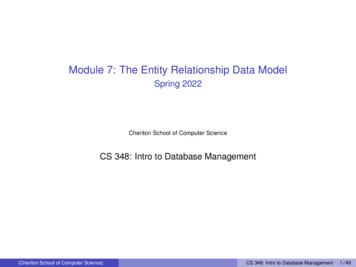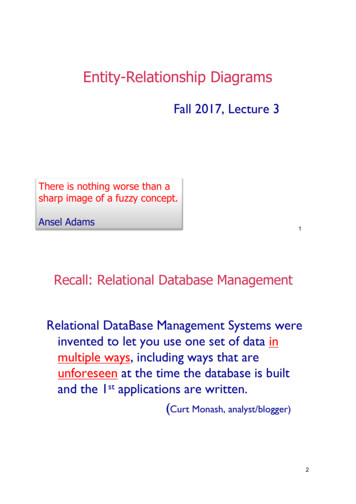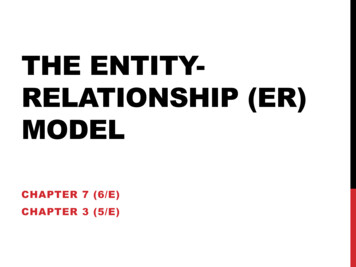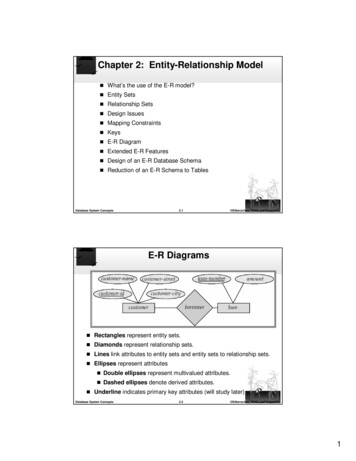
Transcription
Module 7: The Entity Relationship Data ModelSpring 2022Cheriton School of Computer ScienceCS 348: Intro to Database Management(Cheriton School of Computer Science)CS 348: Intro to Database Management1 / 49
Reading Assignments and ReferencesTo be read during the Week of June 13–17: Chapter 6 of course textbook.1 (Material in Sections 6.7 will be covered in the nextmodule.)1Silberschatz, Korth and Sudarshan, Database Systems Concepts, 7th edition(Cheriton School of Computer Science)CS 348: Intro to Database Management2 / 49
OutlineUnit 1: Entity Relationship (ER) ModellingUnit 2: Integrity ConstraintsUnit 3: Extended Entity Relationship (EER) ModellingUnit 4: Design Methodology(Cheriton School of Computer Science)CS 348: Intro to Database Management3 / 49
Overview of the ER Data Model (ERM)Conceptual Data ModelA conceptual data model serves as a first step in formally capturing the metadata forinformation systems. Informal requirements for the underlying information are mappedto such a model.ERM is a conceptual data model proposed in a paper by Peter Chen in 1976. Acollection of metadata expressed in ERM is referred to as an ER model.Metadata is formally captured in terms of entities, attributes, and relationships.ER DiagramThe syntax for specifying an ER model is in the form of a graphical visualization.There are many dialects of ERM and notational conventions for ER diagrams.(Cheriton School of Computer Science)CS 348: Intro to Database Management4 / 49
ER Modeling: EntitiesEntity A distinguishable thing.Entity Set A set of entities of the same variety.Examples of entity sets:1. students currently at University of Waterloo2. flights offered by Air Canada3. burglaries in Ontario during 1994Graphical visualization:Student(Cheriton School of Computer Science)FlightBurglaryCS 348: Intro to Database Management5 / 49
ER Modeling: AttributesAttribute Captures a concrete fact about an entity.Domain A set of possible values for an attribute.Examples of attributes for entities that are students:1. student number2. student name3. majorGraphical visualization:StudentStudentNum(Cheriton School of Computer Science)MajorStudentNameCS 348: Intro to Database Management6 / 49
ER Modeling: RelationshipsRelationship Captures the existence of an association between two or moreentities.Relationship Set A set of relationships of the same variety.Examples of relationship sets:1. students registered in courses2. bank branches, customers and their accounts3. passengers booked on flights4. parents and their childrenGraphical visualizations of the first two examples follow.Note: Relationships are uniquely determined by their participating entities.(Cheriton School of Computer Science)CS 348: Intro to Database Management7 / 49
ER Modeling: Relationships Course(Cheriton School of Computer Science)CourseNumCS 348: Intro to Database Management8 / 49
ER Modeling: Relationships CABStreetAddrCustomerName(Cheriton School of Computer Science)CustomerSINCustomerCityCS 348: Intro to Database Management9 / 49
Multiple Entity Roles and Role NamesRole The purpose served by a particular entity in a relationship.Role Name An identifier indicative of this purpose.Examples of role names: A match takes place between a home team and a visitor.Graphical torTeamNameLocNameNote: Explicit role names are needed whenever a component entity set of arelationship set serves more than one purpose in its relationships.(Cheriton School of Computer Science)CS 348: Intro to Database Management 10 / 49
ER Modeling: Relationships (cont’d)Relationships may also have attributes.Example: A match has a score.Graphical mVisitorTeamNameLocNameNote: Relationships are still uniquely determined by their participating entities.(Cheriton School of Computer Science)CS 348: Intro to Database Management 11 / 49
OutlineUnit 1: Entity Relationship (ER) ModellingUnit 2: Integrity ConstraintsUnit 3: Extended Entity Relationship (EER) ModellingUnit 4: Design Methodology(Cheriton School of Computer Science)CS 348: Intro to Database Management 12 / 49
Constraints in an ER ModelThere are four varieties of integrity constraints in an ER model that are commonlyexpressed with graphical annotations: primary keys binary relationship types existence dependencies general cardinality constraintsGeneral integrity constraints can be captured as sentences in the relational calculus bydefining a mapping of ER diagrams to relational signatures.†Such a mapping also yields both a formal semantics and an ER query language.†Not covered in textbook.(Cheriton School of Computer Science)CS 348: Intro to Database Management 13 / 49
Primary KeysPrimary Key A selection of attributes for an entity set for which facts serve as themeans of reference to its entities.Examples:1. departments are identified by their department number2. employees are identified by their first name, middle initial and last nameGraphical annotation (via loyeeInitial(Cheriton School of Computer Science)ManagerNameSalaryLastNameCS 348: Intro to Database Management 14 / 49
Binary Relationship Typesmany-to-many (N:N): An entity in one entity set can be related to any number ofentities in the other, and the converse also holds. relationship RegisteredIn is many-to-manymany-to-one (N:1): Each entity in one entity set can be related to at most one entityin the other entity set, but no such limit exists for the converse.one-to-many (1:N): Inverse of many-to-one.one-to-one (1:1): Each entity in one entity set can be related to at most one entityin the other, and the same holds for the converse.Note: None of these binary relationship types imply any mandatory participation ofentities.(Cheriton School of Computer Science)CS 348: Intro to Database Management 15 / 49
Binary Relationship Types (cont’d)Examples:1. Employees work in at most one department.2. Employees manage at most one department, and departments are managed by atmost one employee.Graphical annotation (via esDepartment(Cheriton School of Computer Science)CS 348: Intro to Database Management 16 / 49
Existence DependenciesSometimes the existence of an entity depends on the existence of another entity.If x is existence dependent on y , then1. y is a dominant entity, and2. x is a subordinate entity.Example: Transactions are existence dependent on accounts.Graphical annotation (via double boundaries on an entity on School of Computer Science)TransNumAmountCS 348: Intro to Database Management 17 / 49
Identifying Subordinate EntitiesWeak Entity Set An entity set containing subordinate entities.Discriminator A selection of attributes for a weak entity set for which facts serveas the means of distinguishing subordinate entities for any givendominant entity.Example: Each transaction for a given account has a unique transaction number.Graphical annotation (via dashed underlining of attributes for a weak entity on School of Computer Science)TransNumAmountCS 348: Intro to Database Management 18 / 49
Identifying Subordinate Entities (cont’d)A weak entity set must be in a (N:1) relationship with at least one distinct entity set.Graphical annotation (via double boundaries for identifying onshipPrimary Key of a Weak Entity SetThe means of reference to a subordinant entity of a weak entity set are the facts for itsdiscriminator together with the facts for each attribute of the primary keys of the entitysets for dominant entities.Note: This definition is recursive since entity sets of dominant entities may themselvesbe weak (a dominant entity may itself be subordinate to another entity).Note: No cycles of binary relationship sets that are all identifying are allowed in an ERdiagram.(Cheriton School of Computer Science)CS 348: Intro to Database Management 19 / 49
General Cardinality ConstraintsA general cardinality constraint determines lower and upper bounds on the number ofrelationships of a given relationship set in which a component entity must participate.Graphical annotation (via component edge labelling):E(lower,upper).RExample: Students must take between 3 and 5 courses; courses must have between 6and 100 students taking them.Student(3,5)Takes(6,100)CourseNote: The upper bound may be “N”, which indicates that no upper bound exists.(Cheriton School of Computer Science)CS 348: Intro to Database Management 20 / 49
General Integrity ConstraintsGeneral integrity constraints for an ER diagram can be expressed in the relationalcalculus via a mapping to a relational signature ρ satisfying: E /(self) ρ, for each entity set named E ; A /(self, a ) ρ for each attribute named a ; and R /(c1 ,.,ck ) ρ for each relationship set for k -ary associationsnamed R , where ci is either an entity set name or a role name.Note that arity is indicated by a sequence of relational attributes.Example (from Module 1):ρ ( AUTHOR/(self), AID/(self, aid), NAME/(self, name),PUBLICATION/(self), PUBID/(self, pubid), TITLE/(self, title),WROTE/(author, publication) )(Cheriton School of Computer Science)CS 348: Intro to Database Management 21 / 49
Example (cont’d)Some integrity constraints induced by the bibleography ER diagram: Attributes aid and name are single-valued. e, v1 , v2 .(AID(e, v1 ) AID(e, v2 ) v1 v2 ) e, v1 , v2 .(NAME(e, v1 ) NAME(e, v2 ) v1 v2 ) Entities of a given entity set have a given attribute value. e.(AUTHOR(e) AID(e, )) Participating entities of a WROTE relationship must be an author and a publication. e.(WROTE(e, ) AUTHOR(e)) e.(WROTE( , e) PUBLICATION(e)). Values for attribute aid are used to identity authors. e1 , e2 , v .(AUTHOR(e1 ) AID(e1 , v ) AUTHOR(e2 ) AID(e2 , v ) e1 e2 ) An author must have written at least one publication. e.(AUTHOR(e) WROTE(e, ))(Cheriton School of Computer Science)CS 348: Intro to Database Management 22 / 49
Exercises1. Write integrity constraints for each of the following:1.1 No two authors have the same name.1.2 Mary has authored at least two publications.1.3 John has always had a coauthor.2. Remember that relationships may also have attributes.2.1 How should our mapping to a relational signature be revised toaccommodate this?Hint: Consider reification (illustrated in next unit).2.2 What additional integrity constraints would then be induced?3. Remember that a relational database schema begins with a signature.3.1 What problems might there be in considering an ER diagram to also be a relationaldatabase schema defined by this mapping?Hint: Consider the purpose of primary keys and what this implies about the assumptionof constants existing for every value in a universe of an RDB instance.(Cheriton School of Computer Science)CS 348: Intro to Database Management 23 / 49
OutlineUnit 1: Entity Relationship (ER) ModellingUnit 2: Integrity ConstraintsUnit 3: Extended Entity Relationship (EER) ModellingUnit 4: Design Methodology(Cheriton School of Computer Science)CS 348: Intro to Database Management 24 / 49
EER Modelling: Additional Features Structured Attributes Aggregation Specialization Generalization Disjointness(Cheriton School of Computer Science)CS 348: Intro to Database Management 25 / 49
Structured AttributesComposite Attribute Denotes a fixed collection of other attribute facts.Multi-Valued Attribute Denotes a finite set of similar facts.Example: Hobbies are a set of facts about leisure activities; an Address consists of aStreet, City, Province and PostalCode.Graphical biesPostalCodeNote: Composite attributes may be multi-valued, and can be a collection of facts aboutattributes for which some are themselves composite.(Cheriton School of Computer Science)CS 348: Intro to Database Management 26 / 49
AggregationAggregation A relationship set can be aggregated to enable its relationships to behigher-level entities that can in turn participate in other relationships.Example: Accounts are assigned to a given student enrollment.Graphical entNumCourseAccountAccount(Cheriton School of Computer Science)ExpirationDateUserIdCS 348: Intro to Database Management 27 / 49
SpecializationSpecialization An integrity constraint asserting that the entities of one entity set arealso entities of another entity set.Example: Graduate students are students who have a supervisor and a number ofdegrees.Graphical ate(1, 1)SupervisedBy(0, N)DegreesProfessorProfessorNameNote: Enables top down authoring of an ER diagram.(Cheriton School of Computer Science)CS 348: Intro to Database Management 28 / 49
GeneralizationGeneralization An integrity constraint asserting that entities of one entity set are alsoentities of at least one of two or more other entity sets.Example: A vehicle is also either a car or a truck.Graphical CarPriceMaxSpeedMakeAndModel MaxSpeedPassengerCountNotes: Enables bottom up authoring of ER diagrams. Also, the annotation “COVERS”is optional (and always assumed).(Cheriton School of Computer Science)CS 348: Intro to Database Management 29 / 49
DisjointnessDisjointness Two entity sets participating in a generalization are assumed to bedisjoint by default. This can be overridden by a graphical annotation ona generalization.Example: There are entities that can be both a car and a truck, such as a utility vehicle.Graphical APSTonnageTruckAxelCount(Cheriton School of Computer Science)CarMaxSpeedPassengerCountCS 348: Intro to Database Management 30 / 49
Semantics via Integrity Constraints and ViewsAdditional predicates and integrity constraints induced by extended features: (specialization) Entity set GRADUATE is a specialization of entity set STUDENT. e.(GRADUATE(e) STUDENT(e)) (generalization and disjunction) Entity set VEHICLE is a generalization of entitysets TRUCK and CAR. e.(TRUCK(e) VEHICLE(e)) e.(CAR(e) VEHICLE(e)) e.(VEHICLE(e) (TRUCK(e) CAR(e)))If generalization is not annotated with “OVERLAPS”, then the entity sets TRUCKand CAR are disjoint. e.(TRUCK(e) CAR(e)) (aggregation) EnrolledIn relationships can themselves participate ascomponent entities of CourseAccount relationships.(see next slide)(Cheriton School of Computer Science)CS 348: Intro to Database Management 31 / 49
Semantics via Integrity Constraints and Views (cont’d)Use reification on entity set EnrolledIn.Assuming ENROLLEDIN/(student,course) ρ, this involves three steps:1. add to ρ the new ,student) andCOURSE-COMP/(self,course)2. add the integrity constraints e.(ENROLLEDIN-ENT(e) STUDENT-COMP(e, )), e.(ENROLLEDIN-ENT(e) COURSE-COMP(e, )), e1 .(STUDENT-COMP( , e1 ) STUDENT(e1 )), e, e1 , e2 .(STUDENT-COMP(e, e1 ) STUDENT-COMP(e, e2 ) e1 e2 ), e2 .(COURSE-COM( , e2 ) COURSE(e2 )) and e, e1 , e2 .(COURSE-COMP(e, e1 ) COURSE-COMP(e, e2 ) e1 e2 );3. and make ENROLLEDIN a view with the integrity constraint e1 , e2 .ENROLLEDIN(e1 , e2 ) e.(ENROLLEDIN-ENT(e) STUDENT-COMP(e, e1 ) COURSE-COMP(e, e2 )).(Cheriton School of Computer Science)CS 348: Intro to Database Management 32 / 49
Semantics via Integrity Constraints and Views (cont’d)Reification usually replaces a relationship on n entity sets with a new entity set with nbinary relationships on the entity sets.Aggregation retains both perspectives: viewing an association among n entities as ann-ary relationship, and as an entity.Exercise: Draw an ER diagram for the reification of EnrolledIn.(Cheriton School of Computer Science)CS 348: Intro to Database Management 33 / 49
OutlineUnit 1: Entity Relationship (ER) ModellingUnit 2: Integrity ConstraintsUnit 3: Extended Entity Relationship (EER) ModellingUnit 4: Design Methodology(Cheriton School of Computer Science)CS 348: Intro to Database Management 34 / 49
Design MethodologyAn ER diagram for an information system is usually obtained from two sources:1. from parts of ER diagrams for existing information systems; and2. from informal requirements for the information system obtained by requirementselicitation.Issues emerge when authoring an ER diagram from informal requirements. When to introduce an attribute versus an entity set. When to introduce an entity set versus a relationship set. Choosing the arity of relationship sets. The use of extended features such as aggregation. Methodological considerations.(Cheriton School of Computer Science)CS 348: Intro to Database Management 35 / 49
Attributes versus Entity SetsExample: Should one model EMPLOYEE phones by a PhoneNumber attribute, or by aPHONE entity set (with a DialNumber attribute) that is related to the EMPLOYEE entityset by a HasPhone binary relationship set?Rules of thumb: Is it a separate object? Do we maintain information about it? Can several of its kind belong to a single entity? Does it make sense to delete such an object? Can it be missing from some of the entity set’s entities? Can it be shared by different entities?An affirmative answer to any of the above suggests going with the PHONE entity set.(Cheriton School of Computer Science)CS 348: Intro to Database Management 36 / 49
Entity Sets versus Relationship SetsExample: Instead of representing customer branch accounts as ternary relationships,we could represent them as meAccountNumBranchAccountBalanceBalance ameCustomerSINCustomerCityRemember that a relationship on n entity sets can be replaced with a new entity setwith n binary relationships on the entity sets via reification.(Cheriton School of Computer Science)CS 348: Intro to Database Management 37 / 49
A Simple Methodology1. Recognize entity sets.2. Recognize relationship sets and participating entity sets.3. Recognize attributes of entity and relationship sets.4. Define relationship types and existence dependencies.5. Define general cardinality constraints, keys and discriminators.For each step, update the ER diagram and maintain a log of assumptions motivatingthe choices, and of restrictions imposed by the choices.(Cheriton School of Computer Science)CS 348: Intro to Database Management 38 / 49
Case Study: A Registrar’s DatabaseAssume the following informal requirements. Zero or more sections of a course are offered each term. Courses have namesand numbers. In each term, the sections of each course are numbered startingwith 1. Most course sections are taught on-site, but a few are taught at off-site locations. Students have student numbers and names. Each course section is taught by a professor. A professor may teach more thanone section in a term, but if a professor teaches more than one section in a term,they are always sections of the same course. Some professors do not teach everyterm. Up to 50 students may be registered for a course section. Sections with 5 or fewerstudents are cancelled. A student receives a mark for each course in which they are enrolled. Eachstudent has a cumulative grade point average (GPA) which is calculated from allcourse marks the student has received.(Cheriton School of Computer Science)CS 348: Intro to Database Management 39 / 49
Case Study: A Registrar’s Database (cont’d)Step 1. Recognize entity sets, Zero or more sections of a course are offered each term. Courses have namesand numbers. In each term, the sections of each course are numbered startingwith 1. Most course sections are taught on-site, but a few are taught at off-site locations. Students have student numbers and names. Each course section is taught by a professor. A professor may teach more thanone section in a term, but if a professor teaches more than one section in a term,they are always sections of the same course. Some professors do not teach everyterm. Up to 50 students may be registered for a course section. Sections with 5 or fewerstudents are cancelled. A student receives a mark for each course in which they are enrolled. Eachstudent has a cumulative grade point average (GPA) which is calculated from allcourse marks the student has received.(Cheriton School of Computer Science)CS 348: Intro to Database Management 40 / 49
Case Study: A Registrar’s Database (cont’d)CourseSectionProfessor(Cheriton School of Computer Science)Off SiteSectionStudentCS 348: Intro to Database Management 41 / 49
Case Study: A Registrar’s Database (cont’d)Step 2. Recognize relationship sets and participating entity sets. Zero or more sections of a course are offered each term. Courses have namesand numbers. In each term, the sections of each course are numbered startingwith 1. Most course sections are taught on-site, but a few are taught at off-site locations. Students have student numbers and names. Each course section is taught by a professor. A professor may teach more thanone section in a term, but if a professor teaches more than one section in a term,they are always sections of the same course. Some professors do not teach everyterm. Up to 50 students may be registered for a course section. Sections with 5 or fewerstudents are cancelled. A student receives a mark for each course in which they are enrolled. Eachstudent has a cumulative grade point average (GPA) which is calculated from allcourse marks the student has received.(Cheriton School of Computer Science)CS 348: Intro to Database Management 42 / 49
Case Study: A Registrar’s Database Cheriton School of Computer Science)EnrolledInOff SiteSectionStudentCS 348: Intro to Database Management 43 / 49
Case Study: A Registrar’s Database (cont’d)Step 3. Recognize attributes of entity and relationship sets. Zero or more sections of a course are offered each term. Courses have namesand numbers. In each term, the sections of each course are numbered startingwith 1. Most course sections are taught on-site, but a few are taught at off-site locations. Students have student numbers and names. Each course section is taught by a professor. A professor may teach more thanone section in a term, but if a professor teaches more than one section in a term,they are always sections of the same course. Some professors do not teach everyterm. Up to 50 students may be registered for a course section. Sections with 5 or fewerstudents are cancelled. A student receives a mark for each course in which they are enrolled. Eachstudent has a cumulative grade point average (GPA) which is calculated from allcourse marks the student has received.(Cheriton School of Computer Science)CS 348: Intro to Database Management 44 / 49
Case Study: A Registrar’s Database ctionNumSectionTaughtByProfessorEnrolledInOff SiteSectionProfNameProfNum(Cheriton School of Computer mCS 348: Intro to Database Management 45 / 49
Case Study: A Registrar’s Database (cont’d)Step 4. Define relationship types and existence dependencies. Zero or more sections of a course are offered each term. Courses have namesand numbers. In each term, the sections of each course are numbered startingwith 1. Most course sections are taught on-site, but a few are taught at off-site locations. Students have student numbers and names. Each course section is taught by a professor. A professor may teach more thanone section in a term, but if a professor teaches more than one section in a term,they are always sections of the same course. Some professors do not teach everyterm. Up to 50 students may be registered for a course section. Sections with 5 or fewerstudents are cancelled. A student receives a mark for each course in which they are enrolled. Eachstudent has a cumulative grade point average (GPA) which is calculated from allcourse marks the student has received.(Cheriton School of Computer Science)CS 348: Intro to Database Management 46 / 49
Case Study: A Registrar’s Database ctionNumSectionTaughtByProfessorEnrolledInOff SiteSectionProfNameProfNum(Cheriton School of Computer mCS 348: Intro to Database Management 47 / 49
Case Study: A Registrar’s Database (cont’d)Step 5. Define general cardinality constraints, keys and discriminators. Zero or more sections of a course are offered each term. Courses have namesand numbers. In each term, the sections of each course are numbered startingwith 1. Most course sections are taught on-site, but a few are taught at off-site locations. Students have student numbers and names. Each course section is taught by a professor. A professor may teach more thanone section in a term, but if a professor teaches more than one section in a term,they are always sections of the same course. Some professors do not teach everyterm. Up to 50 students may be registered for a course section. Sections with 5 or fewerstudents are cancelled. A student receives a mark for each course in which they are enrolled. Eachstudent has a cumulative grade point average (GPA) which is calculated from allcourse marks the student has received.(Cheriton School of Computer Science)CS 348: Intro to Database Management 48 / 49
Case Study: A Registrar’s Database (cont’d)CourseNumCourseNameCourse(0, N)SectionOfTerm(1, 1)(1, 1)SectionNumSection(6, 50)EnrolledInTaughtByProfessorOff SiteSectionProfNameProfNum(Cheriton School of Computer mCS 348: Intro to Database Management 49 / 49
Reading Assignments and References To be read during the Week of June 13-17: Chapter 6 of course textbook.1 (Material in Sections 6.7 will be covered in the next module.) 1Silberschatz, Korth and Sudarshan, Database Systems Concepts, 7th edition (Cheriton School of Computer Science) CS 348: Intro to Database Management2/49











